Cysteine accessibility in ClC-0 supports conservation of the ClC intracellular vestibule
- PMID: 15897295
- PMCID: PMC2234078
- DOI: 10.1085/jgp.200509258
Cysteine accessibility in ClC-0 supports conservation of the ClC intracellular vestibule
Abstract
ClC chloride channels, which are ubiquitously expressed in mammals, have a unique double-barreled structure, in which each monomer forms its own pore. Identification of pore-lining elements is important for understanding the conduction properties and unusual gating mechanisms of these channels. Structures of prokaryotic ClC transporters do not show an open pore, and so may not accurately represent the open state of the eukaryotic ClC channels. In this study we used cysteine-scanning mutagenesis and modification (SCAM) to screen >50 residues in the intracellular vestibule of ClC-0. We identified 14 positions sensitive to the negatively charged thiol-modifying reagents sodium (2-sulfonatoethyl)methanethiosulfonate (MTSES) or sodium 4-acetamido-4'-maleimidylstilbene-2'2-disulfonic acid (AMS) and show that 11 of these alter pore properties when modified. In addition, two MTSES-sensitive residues, on different helices and in close proximity in the prokaryotic structures, can form a disulfide bond in ClC-0. When mapped onto prokaryotic structures, MTSES/AMS-sensitive residues cluster around bound chloride ions, and the correlation is even stronger in the ClC-0 homology model developed by Corry et al. (2004). These results support the hypothesis that both secondary and tertiary structures in the intracellular vestibule are conserved among ClC family members, even in regions of very low sequence similarity.
Figures

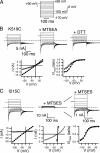
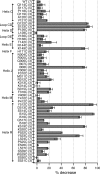


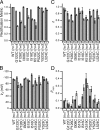
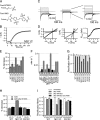

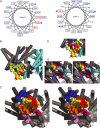
Similar articles
-
Cysteine modification of a putative pore residue in ClC-0: implication for the pore stoichiometry of ClC chloride channels.J Gen Physiol. 2000 Oct;116(4):535-46. doi: 10.1085/jgp.116.4.535. J Gen Physiol. 2000. PMID: 11004203 Free PMC article.
-
Exploration of the pore structure of a peptide-gated Na+ channel.EMBO J. 2001 Oct 15;20(20):5595-602. doi: 10.1093/emboj/20.20.5595. EMBO J. 2001. PMID: 11598003 Free PMC article.
-
Probing the pore of ClC-0 by substituted cysteine accessibility method using methane thiosulfonate reagents.J Gen Physiol. 2003 Aug;122(2):147-59. doi: 10.1085/jgp.200308845. J Gen Physiol. 2003. PMID: 12885876 Free PMC article.
-
Structural basis for ion conduction and gating in ClC chloride channels.FEBS Lett. 2004 Apr 30;564(3):229-33. doi: 10.1016/S0014-5793(04)00210-8. FEBS Lett. 2004. PMID: 15111101 Review.
-
The structural basis of ClC chloride channel function.Trends Neurosci. 2004 Jun;27(6):315-20. doi: 10.1016/j.tins.2004.04.001. Trends Neurosci. 2004. PMID: 15165735 Review.
Cited by
-
Antiport mechanism for Cl(-)/H(+) in ClC-ec1 from normal-mode analysis.Biophys J. 2010 Mar 17;98(6):999-1008. doi: 10.1016/j.bpj.2009.11.035. Biophys J. 2010. PMID: 20303857 Free PMC article.
-
Review. Proton-coupled gating in chloride channels.Philos Trans R Soc Lond B Biol Sci. 2009 Jan 27;364(1514):181-7. doi: 10.1098/rstb.2008.0123. Philos Trans R Soc Lond B Biol Sci. 2009. PMID: 18957380 Free PMC article. Review.
-
A CLC-ec1 mutant reveals global conformational change and suggests a unifying mechanism for the CLC Cl-/H+ transport cycle.Elife. 2020 Apr 20;9:e53479. doi: 10.7554/eLife.53479. Elife. 2020. PMID: 32310757 Free PMC article.
-
Ion channels versus ion pumps: the principal difference, in principle.Nat Rev Mol Cell Biol. 2009 May;10(5):344-52. doi: 10.1038/nrm2668. Epub 2009 Apr 2. Nat Rev Mol Cell Biol. 2009. PMID: 19339978 Free PMC article. Review.
-
CLC anion channel regulatory phosphorylation and conserved signal transduction domains.Biophys J. 2012 Oct 17;103(8):1706-18. doi: 10.1016/j.bpj.2012.09.001. Epub 2012 Oct 16. Biophys J. 2012. PMID: 23083714 Free PMC article.
References
-
- Accardi, A., and C. Miller. 2004. Secondary active transport mediated by a prokaryotic homologue of ClC Cl− channels. Nature. 427:803–807. - PubMed
-
- Akabas, M.H. 1998. Channel-lining residues in the M3 membrane-spanning segment of the cystic fibrosis transmembrane conductance regulator. Biochemistry. 37:12233–12240. - PubMed
-
- Akabas, M.H., D.A. Stauffer, M. Xu, and A. Karlin. 1992. Acetylcholine receptor channel structure probed in cysteine-substitution mutants. Science. 258:307–310. - PubMed

